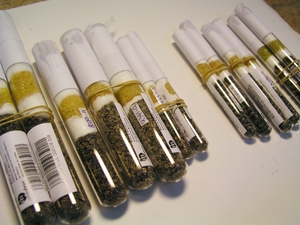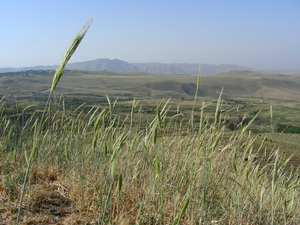Systematic conservation of CWR diversity involves the complementary application of in situ and ex situ strategies. The precise combination of in situ and ex situ techniques will vary according to the taxon being conserved, resources available for conservation and the potential value and use of the species.

In situ conservation: involves the location, designation, management and monitoring of populations to conserve a particular species within its natural habitat or where it has developed its distinctive characteristics (Maxted et al. 1997c). For wild taxa such as CWR, in situ conservation involves the establishment of genetic reserves. Genetic reserve establishment may be defined as “the location, management and monitoring of genetic diversity in natural wild populations within defined areas designated for active, long-term conservation” (Maxted et al. 1997c). Practically, this involves the location, designation, management and monitoring of genetic diversity at a particular location. The site is actively managed, even if that active management only involves regular monitoring of the target taxa, and conservation is long term, because significant resources will have been invested to establish the genetic reserve (Maxted et al. 2008d).
Since the inception of the CBD, in situ conservation has been indentified as the primary conservation strategy, with ex situ employed as a backup. This is because, in contrast to ex situ conservation, in situ conservation promotes natural gene exchange and continued evolution of CWR populations (CBD 1992, Maxted et al. 1997a, FAO 2001, Heywood and Dulloo 2005, Stolton et al. 2006).
Methodologies for the design, establishment, management and monitoring of CWR in genetic reserves are available (see Gadgil et al. 1996, Maxted et al. 1997b, Heywood and Dulloo 2005, Stolton et al. 2006, Iriondo et al. 2008); however, full practical implementation remains limited. As noted by Meilleur and Hodgkin (2004), there are “weak links between the ‘site-selection and/or management-recommendations’ process and the ‘official-protected-site and/or management-change-designation’ process”. In other words, moving from the stage of identifying genetic reserve sites and making management recommendations, to official site designation and practical management remains, a significant challenge. The lack of notable examples of the ‘CWR site selection to reserve establishment’ process may possibly be explained by the inherent requirement to bring together the agricultural conservation community, who identify the priority CWR taxa and sites, and the ecological conservation community, who actively manage the protected areas in which the CWR genetic reserves can be established.
Ex situ conservation: conservation of components of biological diversity outside their natural habitats (CBD 1992). The application of this strategy involves the location, sampling, transfer and storage of samples of the target taxa away from their native habitat (Maxted et al. 1997c).
Are CWR already conserved?
Both the in situ and ex situ conservation of CWR is currently inadequate.
In situ conservation:
- CWR are found in existing protected areas but are not monitored and actively managed.
- There are very few examples of active in situ CWR conservation.
- The Second Report on the State of the World’s Plant Genetic Resources for Food and Agriculture (SoWPGR-2) (FAO 2010a) highlights the relatively little progress made in conserving wild PGRFA outside protected areas.
Ex situ conservation: although efforts to conserve PGRFA have historically been focussed on ex situ conservation (e.g. see Frankel and Bennet 1970, Frankel 1973, Frankel and Hawkes 1975, Brown et al. 1989, Frankel et al. 1995, Guarino et al. 1995, Hawkes et al. 2000, Smith et al. 2003), the SoWPGR-2 has noted that while the total number of ex situ accessions has increased since the first report (FAO 1998), CWR diversity is still under-represented. For example, only about 7.6% of ex situ PGR accessions reported by EURISCO are from wild populations (137,639 out of a total of about 1,800,000 accessions).
The Interactive Toolkit for Crop Wild Relative Conservation Planning was developed within the framework of the SADC CWR project www.cropwildrelatives.org/sadc-cwr-project (2014-2016),
which was co-funded by the European Union and implemented through ACP-EU Co-operation Programme in Science and Technology (S&T II) by the African, Caribbean and Pacific (ACP) Group of States.
Grant agreement no FED/2013/330-210.





